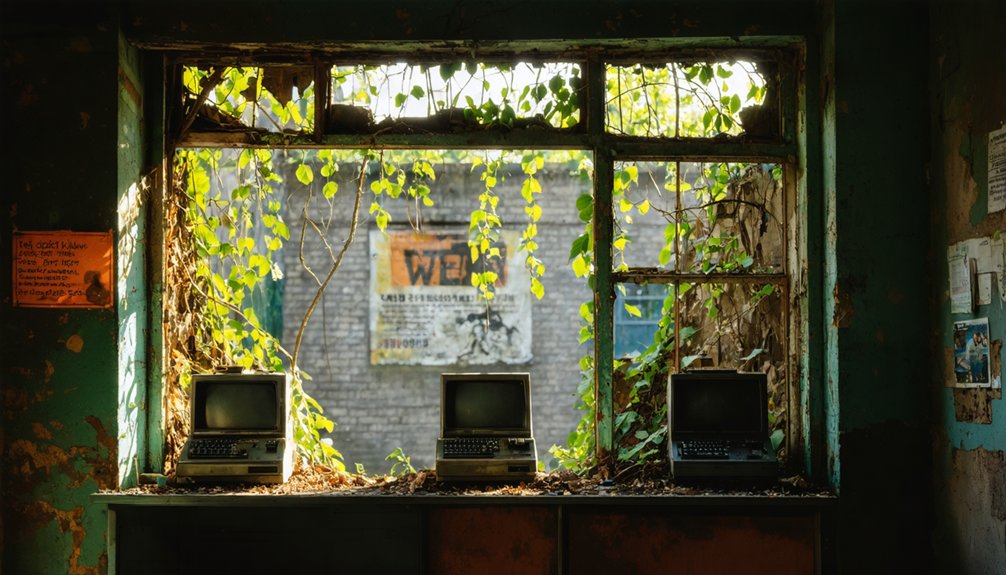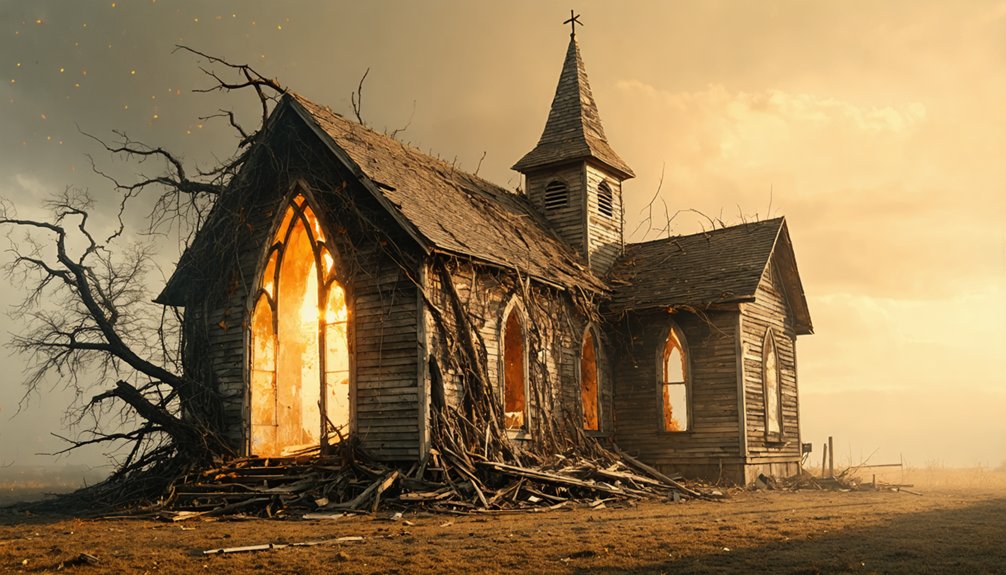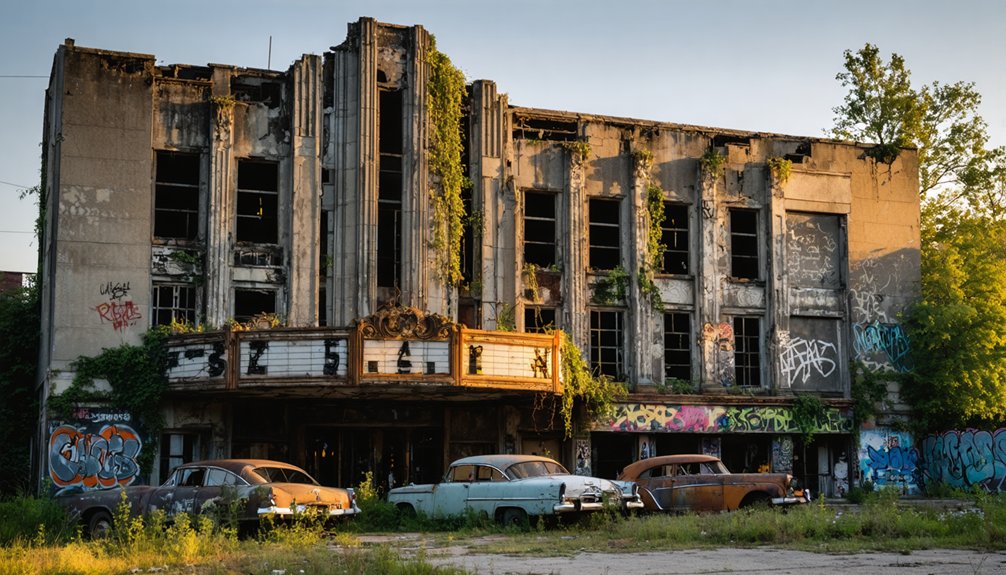When capturing post-apocalyptic ghost towns, you’ll want to shoot during golden hours when sunlight creates dramatic shadows across crumbling facades. Use a sturdy tripod for long exposures that reveal layers of decay. Frame wide-angle shots to showcase urban abandonment, then zoom in on nature’s reclamation—vines breaking through concrete, moss consuming metal. Always respect these spaces by obtaining permissions and honoring the communities who once called these places home. Their silent stories await your lens.
Key Takeaways
- Use a wide-angle lens to document expansive urban decay while capturing intimate details with macro photography.
- Schedule shoots during golden hour to emphasize textures in peeling paint and create dramatic shadows across abandoned structures.
- Balance artistic documentation with ethical considerations by obtaining permissions and respecting the historical significance of abandoned places.
- Photograph the interplay between human structures and nature’s reclamation through pioneer species and emerging ecosystems.
- Develop a narrative approach that transcends “ruin porn” by contextualizing decay within historical patterns of disinvestment and abandonment.
The Silent Narratives of Abandoned Urban Landscapes

As dusk settles over America’s forgotten neighborhoods, the silent narratives of abandoned urban landscapes begin to whisper their stories.
You’ll find these haunting spaces concentrated in historically Black neighborhoods across the Rust Belt, where deindustrialization has claimed over 269 census tracts that lost half their housing since 1970.
When you venture into urban exploration, you’re walking through the physical manifestation of economic collapse—boarded windows and crumbling facades telling stories of vanished livelihoods and community dispersal.
Each vacant lot represents not just physical decay but the erosion of human connection. In Detroit’s McDougall-Hunt Neighborhood, the environment resembles an undeveloped greenfield site rather than an urban area.
The historical significance extends beyond aesthetic ruin—these spaces document America’s uneven development.
Unlike Canadian cities with similar industrial histories, these extreme abandonments reveal uniquely American patterns of disinvestment, where economic and racial inequalities manifest in the very infrastructure around you.
Photographic Techniques for Documenting Structural Decay
When you stand before the skeletal remains of a forgotten town, your camera becomes more than a tool—it transforms into a witness. Mount it on a sturdy tripod and embrace the golden hours, when sunlight crawls across peeling paint and rusted metal, revealing textures otherwise hidden in harsh daylight.
In forgotten places, the camera’s eye resurrects whispers of history from silent walls and abandoned dreams.
Your composition techniques should tell stories—wide-angle shots capture the haunting expanse, while detail frames preserve the intimate whispers of abandonment.
Experiment with lighting effects: sweep colored gels across crumbling interiors during long exposures, or paint with light to resurrect shadows where footsteps once echoed. Always prioritize safety and permission when accessing these fragile historical sites, as structural integrity may be compromised.
In post-processing, resist the urge to sanitize decay. Instead, subtly enhance what’s already there—contrast that accentuates weathered wood, monochrome conversions that strip time to its essence—preserving the raw poetry of dissolution. Consider throwing sand into your compositions to create dynamic movement that evokes the relentless reclamation of these spaces by nature.
Nature’s Reclamation: The Ecological Transformation of Ghost Towns

Where humans retreat, nature advances with relentless patience, turning forgotten settlements into living laboratories of ecological transformation.
You’ll witness pioneer species—mosses and lichens—creeping over concrete bones, their quiet work breaking down the foundations of civilization.
Through your lens, capture climbing vines strangling brick facades and trees erupting through wooden floors, their roots prying apart what man once sealed.
Frame the stark beauty of ecological hotspots forming in crumbling corners where birds nest in rusted machinery and foxes den beneath collapsing porches.
The story unfolds in layers: first the fragile green shoots, then the sturdy shrubs, finally the towering trees.
Each abandoned room becomes a microhabitat, each forgotten street a corridor for wildlife returning to reclaim what was always theirs.
In places like Pripyat near Chernobyl, the absence of human interference has created a wildlife sanctuary where animal populations thrive amid the haunting silence of abandonment.
In Houtouwan, a once-bustling Chinese fishing village has been dramatically transformed as climbing vines have completely engulfed walls and streets in less than three decades since abandonment.
Ethical Considerations in Ghost Town Exploration and Documentation
Beyond the thrill of discovery and the artistry of documentation lies a shadowy ethical landscape you must navigate with each ghost town you explore.
Tread carefully between curiosity and trespass—seeking legal permissions isn’t merely bureaucratic formality but respect for history’s rightful custodians.
You’ll find yourself walking a tightrope: capturing crumbling facades without disturbing their delicate dignity.
Remember, the mantra “take only photographs, leave only footprints” isn’t suggestion but commandment. These decaying remnants deserve your protection, not exploitation.
True explorers engage with local communities, listening to stories from those whose ancestors breathed life into these now-silent streets. Protect locations from damage by maintaining location anonymity when sharing your discoveries online.
Their memories matter more than your Instagram aesthetics.
Don’t reduce these places to “ruin porn.” Instead, become a thoughtful storyteller honoring the ghosts who whisper through broken windows and collapsed doorways.
Research thoroughly to understand potential building hazards before entering any abandoned structure to ensure your personal safety and preserve the site’s integrity.
The Cultural Impact of Ghost Towns in Contemporary Media

How dramatically ghost towns have transformed from forgotten relics to potent cultural symbols across today’s media landscape.
You’ll find these crumbling monuments of urban decay captured through Noel Kerns’ haunting light-painted photographs or serving as backdrops in films like Quantum of Solace, their skeletal structures perfect for post-apocalyptic storytelling.
When you listen to The Specials’ 1981 hit “Ghost Town,” you’re experiencing cultural nostalgia filtered through Jerry Dammers’ two-tone lens—a sonic portrait of abandonment that still resonates today.
These deserted places permeate our literature, music, and visual arts, whispering stories of impermanence.
They’ve become creative wellsprings where artists explore themes of isolation and resilience, allowing you to confront mortality while celebrating freedom from society’s constraints.
The preservation of these towns in a state of arrested decay creates a unique temporal suspension that artists continually mine for emotional and aesthetic impact.
The aesthetics surrounding ghost cities have significantly influenced online subcultures, particularly the dreamlike qualities of Vaporwave and Hauntology that romanticize abandoned spaces.
Frequently Asked Questions
How Can I Safely Enter Condemned Buildings in Ghost Towns?
You’ll need written permission first. Donning sturdy boots, respirators, and gloves, scout crumbling doorways before entering. Your urban exploration demands vigilance—always bring companions as shadows dance through safety precautions.
Are Permits Required to Photograph Abandoned Private Property?
With 89% of trespassing cases resulting in legal action, you’ll need permits. Beyond crumbling walls and faded memories lie photography ethics and legal ramifications that could haunt you through rusted courtroom doors.
What Gear Protects Against Toxins or Radiation in Contaminated Towns?
You’ll need full-face respirators with filters, sealed hazmat suits, lead-lined vests, and radiation detectors that whisper warnings as invisible death seeps through the crumbling walls of forgotten lives.
How Do I Locate Unpublished or Unmarked Ghost Towns?
Despite their spectral absence from official maps, you’ll unearth forgotten settlements through historical research in county archives, comparing old-to-new maps, and conducting urban exploration guided by local elders whose memories preserve these crumbling, whispered places.
Can I Legally Collect Artifacts From Abandoned Ghost Towns?
You can’t legally collect artifacts without permissions. Dusty relics beckon from crumbling walls, but artifact ownership carries haunting legal implications—fines and imprisonment await those who disturb these whispering remnants.
References
- https://www.losethemap.com/scariest-ghost-towns-in-the-world/
- https://www.scribd.com/document/710637026/Ghost-Town-Thesis
- https://www.geotab.com/ghost-towns/
- https://en.wikipedia.org/wiki/Ghost_town
- https://www.youtube.com/watch?v=EfgUki1ZtGQ
- https://www.atlasobscura.com/users/guylarocque/lists/ghost-towns
- https://vocal.media/education/ghost-town-skz64x0gye
- https://en.wikipedia.org/wiki/Wikipedia:WikiProject_Ghost_towns/Assessment
- https://schoolofcities.utoronto.ca/neighbourhood-abandonment-in-the-american-rust-belt/
- https://digitalcollections.drew.edu/UniversityArchives/ThesesAndDissertations/CSGS/MLitt/2020/Shively/openaccess/JLShively.pdf



